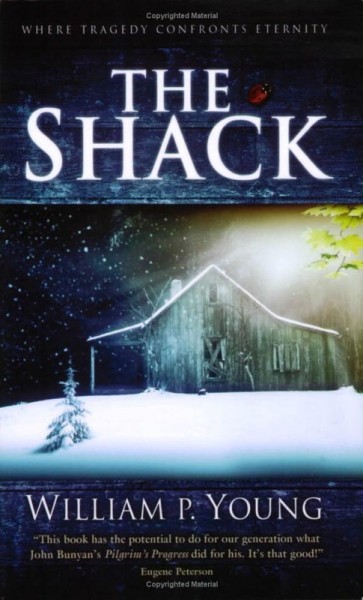Book Review – The Shack

Title: The Shack
Author: William P. Young
Copyright Date: paperback, July 1st, 2007; 256 pages
Publisher: Windblown Media
ISBN: 0964729237
Brief Character List: Mackenzie Philips, Nan his wife, Missy the child who is murdered, the holy trinity as played by: Papa, Jesus, and Sarayu
Enotes Synopsis:
The Shack by William Paul Young was published in 2007 by Windblown Media. It is a New York Times bestseller, with more than five million copies in print by 2009. The story opens with a few simple characters, including Mackenzie Allen Phillips, his daughter, Missy, his wife, Nan, and a few family friends.
The story turns sinister, however, when Missy gets abducted during an otherwise routine family vacation. Evidence surfaces that she may have been brutally murdered in an abandoned shack, located in the remote Oregon wilderness country. Suspense builds when, four years later, the protagonist, Mack (Mackenzie Phillips) receives a note “from God” (signed by “Papa”) inviting him back to that very same shack for one weekend.
With great reservation and suspicion, Mack goes to the shack. Upon arriving there, Mack is greeted unexpectedly, however, by an African-American woman, Elouisa, who confesses to sending the mysterious note, as she is called “Papa” as a nickname. It is here he also meets other pivotal characters, including Jesus, who is an Asian-looking handyman and maintenance worker, and Sarayu, the gardener. All three of these characters greet Mack upon his arrival at the notorious “shack,” and he is taken aback by their graciousness and hospitality.
As Mack spends more time at the shack, his relationship with Papa and the others grows more intimate and real, Mack gradually learns to cope with Missy’s loss. Each of the characters is representative of some bigger idea; they are symbols of other ideas or religious figures. Jesus, for instance, is representative of the obvious Christ-like qualities, values, and words. “Papa,” otherwise known as Elouisa, seems to be Mack’s guiding voice, much like the sagacious voice of God himself. Sarayu, the gardener, teaches Mack to tend his life much the same way one would tend a garden — with care and nurturing. She could be considered the “Virgin Mary” character, but is too down-to-earth and utilitarian to be labeled as entirely feminine. Her role is closer to that of the “Holy Spirit,” spoken of as part of the Trinity in religious circles: Father (God), Son (Jesus), and the Holy Spirit or Holy Ghost, which is the “tool” or “voice” of God Himself.
As the story progresses, we watch Mack’s relationship to each of these representative characters grow and develop, just as his spiritual relationship also matures. He gains a gradual acceptance of Missy’s fate through his stay at The Shack, and the book becomes a religious metaphor.
In one final plot twist, there is a Jeep accident with another character, Willie, that lands Mack in the hospital. The stay allows him to comprehend the totality of everything else in the novel that transpired, and allows him to gain new perspective on life at large. By novel’s end, experts are able to locate and deduce evidence of Missy’s demise, arrest her killer, and connect him to other murders of little girls in the area. There is a brief “after words” note at the end, allowing the reader to explore Mack’s “current” life even deeper.
What I Thought: I did not even finish the book. I read the Forward-6, and then 14 until the end. I actually spent more time reading online critiques of the book than I did reading the actual book. Religion is something I am in no way interested in. When I was a child I never could grasp the whole Trinity thing and I still don’t or care to now. Theology is not my thing and this book buries itself in religious theology of the Holy Trinity. Only in the ending of the book did I find some glimmer of returning to reality in Mac waking up and realizing that he had been in a terrible accident and not at the Shack with his “new friends” God, Jesus, and the Holy Spirit.
For those that enjoying digging in to the theology and dissecting the Bible down into what is means and what it teaches, I think this book may have a ton of thoughts to offer you. For me, who is not interested in such topics or debates, I found this book to sound like the old cartoon voice going “Whaaa whaaa whaaa whaaa” in my head as I tried to read and get into the text of this book.
On a Side Note: USA Today article, and an interesting one on the “twisted truths” of The Shack, also Tim Challies blog called Informing the Reforming


